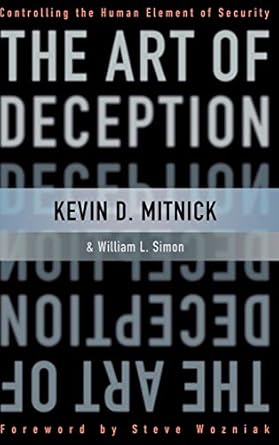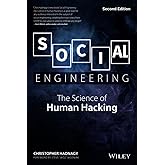
無料のKindleアプリをダウンロードして、スマートフォン、タブレット、またはコンピューターで今すぐKindle本を読むことができます。Kindleデバイスは必要ありません。
ウェブ版Kindleなら、お使いのブラウザですぐにお読みいただけます。
携帯電話のカメラを使用する - 以下のコードをスキャンし、Kindleアプリをダウンロードしてください。



 サンプル
サンプル The Art of Deception: Controlling the Human Element of Security ハードカバー – 2002/10/4
購入オプションとあわせ買い
Kevin Mitnick's exploits as a cyber-desperado and fugitive form one of the most exhaustive FBI manhunts in history and have spawned dozens of articles, books, films, and documentaries. Since his release from federal prison, in 1998, Mitnick has turned his life around and established himself as one of the most sought-after computer security experts worldwide. Now, in The Art of Deception, the world's most notorious hacker gives new meaning to the old adage, "It takes a thief to catch a thief."
Focusing on the human factors involved with information security, Mitnick explains why all the firewalls and encryption protocols in the world will never be enough to stop a savvy grifter intent on rifling a corporate database or an irate employee determined to crash a system. With the help of many fascinating true stories of successful attacks on business and government, he illustrates just how susceptible even the most locked-down information systems are to a slick con artist impersonating an IRS agent. Narrating from the points of view of both the attacker and the victims, he explains why each attack was so successful and how it could have been prevented in an engaging and highly readable style reminiscent of a true-crime novel. And, perhaps most importantly, Mitnick offers advice for preventing these types of social engineering hacks through security protocols, training programs, and manuals that address the human element of security.
- 本の長さ368ページ
- 言語英語
- 出版社Wiley
- 発売日2002/10/4
- 寸法16.35 x 3.07 x 23.46 cm
- ISBN-100471237124
- ISBN-13978-0471237129
この商品をチェックした人はこんな商品もチェックしています
商品の説明
レビュー
Mitnick is the most famous computer hacker in the world. Since his first arrest in 1981, at age 17, he has spent nearly half his adult life either in prison or as a fugitive. He has been the subject of three books and his alleged 1982 hack into NORAD inspired the movie WarGames. Since his plea-bargain release in 2000, he says he has reformed and is devoting his talents to helping computer security. It's not clear whether this book is a means toward that end or a, wink-wink, fictionalized account of his exploits, with his name changed to protect his parole terms. Either way, it's a tour de force, a series of tales of how some old-fashioned blarney and high-tech skills can pry any information from anyone. As entertainment, it's like reading the climaxes of a dozen complex thrillers, one after the other. As a security education, it's a great series of cautionary tales; however, the advice to employees not to give anyone their passwords is bland compared to the depth and energy of Mitnick's description of how he actually hacked into systems. As a manual for a would-be hacker, it's dated and nonspecific -- better stuff is available on the Internet―but it teaches the timeless spirit of th e hack. Between the lines, a portrait emerges of the old-fashioned hacker stereotype: a socially challenged, obsessive loser addicted to an intoxication sense of power that comes from stalking and spying. (Oct.)
Forecast: Mitnick's notoriety and his well written, entertaining stories should generate positive word-of-mouth. With the double appeal of a true-crime memoir and a manual for computer security, this book will enjoy good sales. (Publishers Weekly, June 24, 2002)
"...an interesting read..." (www.infosecnews.com, 17 July 2002)
"...highly entertaining...will appeal to a broad audience..." (Publishing News, 26 July 2002)
The world's most famous computer hacker and cybercult hero, once the subject of a massive FBI manhunt for computer fraud, has written a blueprint for system security based on his own experiences. Mitnick, who was released from federal prison in 1998 after serving a 22-month term, explains that unauthorized intrusion into computer networks is not limited to exploiting security holes in hardware and software. He focuses instead on a common hacker technique known as social engineering in which a cybercriminal deceives an individual into providing key information rather than trying to use technology to reveal it. Mitnick illustrates the tactics comprising this "art of deception" through actual case studies, showing that even state-of-the-art security software can't protect businesses from the dangers of human error. With Mitnick's recommended security policies, readers gain the information their organizations need to detect and ward off the threat of social engineering. Required reading for IT professionals, this book is highly recommended for public, academic, and corporate libraries. [This should not be confused with Ridley Pearson's new thriller, The Art of Deception. ―Ed]―Joe Accardi, William Rainey Harper Coll. Lib., Palatine, IL (Library Journal, August 2002)
He was the FBI's most-wanted hacker. But in his own eyes, Mitnick was simply a small-time con artist with an incredible memory, a knack for social engineering, and an enemy at The New York Times. That foe, John Markoff, made big bucks selling two books about Mitnick - without ever interviewing him. This is Mitnick's account, complete with advice for how to protect yourself from similar attacks. I believe his story. (WIRED Magazine, October 2002)
Kevin Mitnick spent five years in jail at the federal authorities' behest, but The Art of Deception: Controlling the Human Element of Security (Kevin Mitnick and William Simon), reveals that he was no lowly grifter. Rather, by impersonating others in order to talk guileless employees out of access protocols, Mr. Mitnick was practicing "the performance art called social engineering."
While every society has had its demimonde-like the Elizabethan coney catchers who duped visitors to 16th-century London--it's in the United States that con artists assumedlegendary status. The definitive book is still The Big Con from 1940 (Anchor Books), which commemorates a golden age already receding when it was published: the grifters it describes--like the High Ass Kid and Slobbering Bob--thrived between 1914 and 1929, when technological advances and unparalleled prosperity generated a roller-coaster stock market.
That sounds a lot like the past decade. So how did the culture of the con do during the Internet era? On Mr. Mitnick's evidence, it flourished and evolved. The Art of Deception is itself a bit of a fraud as far as advice on upgrading security. But the book does deliver on "social engineering" exercises. Some aren't even illegal and Mr. Mitnick -- weasel that he is -- lovingly records their most elaborate convolutions. One way or another, you'll find the information useful. (Red Herring, October 2002)
"Mitnick outlines dozens of social engineering scenarios in his book, dissecting the ways attackers can easily exploit what he describes as 'that natural human desire to help others and be a good team player.'" (Wired.com, October 3, 2002)
Finally someone is on to the real cause of data security breaches--stupid humans. Notorious hacker Kevin Mitnick--released from federal prison in January 2000 and still on probation--reveals clever tricks of the "social engineering" trade and shows how to fend them off in The Art of Deception: Controlling the Human Element of Security (Wiley, $27.50).
Most of the book, coauthored by William Simon (not the one running for governor of California), is a series of fictional episodes depicting the many breathtakingly clever ways that hackers can dupe trusting souls into breaching corporate and personal security--information as simple as an unlisted phone number or as complicated as plans for a top-secret product under development. The rest lays out a fairly draconian plan of action for companies that want to strengthen their defenses. Takeaway: You can put all the technology you want around critical information, but all it takes to break through is one dolt who gives up his password to a "colleague" who claims to be working from the Peoria office.
What's useful about this book is its explanation of risks in seemingly innocuous systems few people think about. The caller ID notification that proves you're talking to a top executive of your firm? Easily forged. The password your assistant logs in with? Easily guessed. The memos you toss into the cheap office shredder? Easily reconstructed. The extension that you call in the IT department? Easily forwarded.
Physical security can be compromised, too. It's not hard to gain access to a building by "piggybacking" your way in the door amid the happy throng returning from lunch. You'd better have confidence in your IT professionals, because they're likely to have access to everything on the corporate system, including your salary and personal information. Mitnick offers some ideas for plugging these holes, like color-coded ID cards with really big photos.
Implementing the book's security action plan in full seems impossible, but it's a good idea to warn employees from the boss down to the receptionist and janitors not to give out even innocuous information to people claiming to be helpful IT folks without confirming their identity--and to use things like encryption technology as fallbacks. Plenty of would-be Mitnicks--and worse--still ply their trade in spaces cyber and psychological. --S.M. (Forbes Magazine - October 14, 2002)
"...the book describes how people can get sensitive information without even stepping near a computer through 'social engineering' -- the use of manipulation or persuasion to deceive people by convincing them that you are someone else." (CNN.com's Technology section, October 9, 2002)
"...engaging style...fascinating true stories..." (The CBL Source, October/December 2002)
"…the book describes how people can get information without even stepping near a computer…" (CNN, 16 October 2002)
"…each vignette reads like a mini-cybermystery thriller…I willingly recommend The Art of Deception. It could save you from embarrassment or an even worse fate…" (zdnet.co.uk, 15 October 2002)
"…details the ways that employees can inadvertently leak information that can be exploited by hackers to compromise computer systems…the book is scary in ways that computer security texts usually do not manage to be…" (BBC online, 14 October 2002)
"…more educational than tell-all…" (Forbes, 2 October 2002)
"…would put a shiver into anyone responsible for looking after valuable computer data…the exploits are fictional but realistic…the book is about hacking peoples heads…" (The Independent, 21 October 2002)
"…the key strength of The Art of Deception is the stream of anecdotes - with explanations about how and why hacks succeed…provides a solid basis for staff training on security…" (Information Age, October 2002)
"…should be on the list of required reading. Mitnick has done an effective job of showing exactly what the greatest threat of attack is - people and their human nature…" (Unix Review, 18 October 2002
"…disturbingly convincing…" (Fraud Watch, Vol.10, No.5, 2002
"…the worlds most authoritative handbook…an unputdownable succession of case studies…chilling…trust me, Kevin Mitnick is right…" (Business a.m, 29 October 2002)
"…a damn good read…I would expect to see it as required reading on courses that cover business security…Should you read this book? On several levels the answer has to be yes. If you run your own business, work in one, or just want a good read, this is worth it…" (Acorn User, 29 October 2002)
"...the analysis of individual cases is carried out thoroughly...ultimately, the value of the book is that it may encourage security managers to be more assiduous in teaching their staff to check the identities of the people they deal with, and better corporate security will be the result..." (ITWeek, 1 November 2002)
"...a penetrating insight into the forgotten side of computer security..." (IT Week, 4 November 2002)
"...a highly entertaining read...Mitnick has a laid-back style which makes the book easy to read and of great interest, even to those of us who have no interest in computers..." (Business Age, September 2002)
"...one of the hacker gurus of our time...makes it abundantly clear that everyone can be fooled and cheated by the professionals...." (The Times Higher Education Supplement, 15 November 2002)
"...focuses on teaching companies how to defeat someone like him…full of specific examples of the ways apparently innocent bits of information can be stitched together to mount a comprehensive attack on an organisation's most prized information..." (New Scientist, 23 November 2002)
"...all simple things, little titbits of seemingly innocuous information, which when gathered together give the hacker the power to cripple the biggest corporation or the smallest home business..." (New Media Age, 14 November 2002)
"…highly acclaimed…a fascinating account…" (Information Security Management, November 2002)
"...His new book, The Art of Deception, presents itself as a manual to help companies defeat hackers..." Also listed in recommended reading list (The Guardian, 13 December 2002)
“…gets it’s point across and contains some valuable pointers…”(MacFormat, January 2003)
“…supremely educational…a sexy way to hammer home a relevant point…what makes it sing is the clear information that Mitnick brings to the table…”(Business Week, 8 January 2003)
“…Indispensable…”(Focus, February 2003)
"...incredibly intriguing...a superb book which would be beneficial for anyone to read..." (Telecomworldwire, 4 February 2003)
"...a good overview of one of the most neglected aspects of computer security..." (Technology and Society, 7 February 2003)
"...fascinating to read...should strike fear into the hearts of commercial computer security departments..." (Business Week, 3 September 2003)
"...a penetrating insight into the forgotten side of computer security..." (Accountancy Age, 19 February 2003)
Top 10 Popular Science Books (New Scientist, 21 February f2003)
"...should be assigned as required reading in every IT department...excellent advice..." (Electronic Commerce Guide, 12 February 2003)
“…an interesting and educational read for anyone with a role to play in corporate security…”(Computer Business Review, 6 March 2003)
“…if you were not having security nightmares before, read this book and you certainly will…” (IT Showcase News, 6 March 2003)
“….easy to understand and actually fun to read…”(Slashdot, 6 March 2003)
“…a good read, well written…” (Managing Information, March 2003)
“…structured like a mini detective story series…the unfolding attacks are compulsive reading…” (Aberdeen Evening Express, 7 June 21003)
“…a real eye-opener…well written and produced…an easy and valuable read…” (Accounting Web, 19 June 2003)
“…a superb book which would be beneficial for anyone to read…” (M2 Best Books, 4 February 2003)
“…the insights for earlier chapters are fascinationg, and that alone makes it worth blagging a copy for review…”(Mute, Summer/Autumn 2003)
“…a good read, well-written…this accessibility makes it doubly important…” (Managing Information – 5 star rating, October 2003)
著者について
WILLIAM SIMON is a bestselling author of more than a dozen books and an award-winning film and television writer.
登録情報
- 出版社 : Wiley; 第1版 (2002/10/4)
- 発売日 : 2002/10/4
- 言語 : 英語
- ハードカバー : 368ページ
- ISBN-10 : 0471237124
- ISBN-13 : 978-0471237129
- 寸法 : 16.35 x 3.07 x 23.46 cm
- Amazon 売れ筋ランキング: - 407,787位洋書 (洋書の売れ筋ランキングを見る)
- - 338位Cryptography Algorithms
- - 505位Web Encryption
- - 512位Computer Hacking
- カスタマーレビュー:
著者について

著者の本をもっと見つけたり、似たような著者を調べたり、おすすめの本を読んだりできます。

著者の本をもっと見つけたり、似たような著者を調べたり、おすすめの本を読んだりできます。
カスタマーレビュー
上位レビュー、対象国: 日本
レビューのフィルタリング中に問題が発生しました。後でもう一度試してください。
- 2003年6月7日に日本でレビュー済みAmazonで購入困難な状況に追い込まれたとき、人間は、誰も考えなかったような、とんでもないことを思いつく。本書に書かれている、ソーシャルエンジニアの犯行は、どれも、「よくこんなことを考えつくものだ」「なるほど、こんな手があったのか」と目から鱗が落ちる騙しの技術(Art of Deception)ばかりだ。読み物として、本当に面白い。「1ダースの複雑なミステリーのクライマックスの部分を次から次へと読むようなもの」と評されるのも納得できる。ただ、こうした、人間の負の想像力&創造力がもっと別の肯定的な方面に発揮できないか、と思うのは評者だけだろうか。
- 2002年11月20日に日本でレビュー済みAmazonで購入英語でかかれていることを忘れて一気に読んでしまった。とにかく面白い。いくらファイアウォールを導入し、IDSで監視し、セキュリティポリシーを制定しても、人間を騙せば崩壊してしまう、ということが著者の体験から生き生きと書かれている。詐欺関係の用語だけ押さえれば、文章自体は平易で読みやすい。ありきたりのソーシャルエンジニアリング(ごみ箱あさりなど)では満足できない人にお薦め。
- 2003年1月19日に日本でレビュー済みAmazonで購入Plain bad. The book is a compendum of anecdotal evidence, presented as "true stories" that makes the well-known point that a security policy is as good/bad as its worst element. Well, we knew that already.
Each story is told twice, the second time being a superficial and elementary analysis - so one can skip about half the book without loss. Many factual errors, some of them quite telling about the author technology background - or the lack of it (an anonymous FTP account is called "a program", etc.).
Overall, this book does not even remotely qualify as a book on security. It is shallow and trivial about social engineering, and has no useful information on the technology aspects of information security.
As for its entertainment value - well - either one of Grisham, Chandler or Poe would make a much better reading.
他の国からのトップレビュー
-
 R.T.2023年8月25日にブラジルでレビュー済み
R.T.2023年8月25日にブラジルでレビュー済み5つ星のうち5.0 Excelente livro, super recomendo!
Amazonで購入Excelente livro, super recomendo, principalmente se você trabalha na área de segurança da informação!
-
 TheWildBoy2021年8月2日にアメリカ合衆国でレビュー済み
TheWildBoy2021年8月2日にアメリカ合衆国でレビュー済み5つ星のうち5.0 Fascinating book
Amazonで購入I bought this book in 2008, and read it after I got it. I was in love with cyber-security and social engineering was the theme those days. I never reviewed the book back then but I reread this book again yesterday and it hit me that Kevin's ideas are some of the most profound ideas when it comes to human behavior.
Our tendency to be helpful.
Our tendency to let someone new come into our lives
Etc,..
I will be honest, after spending 13 years in financial and marketing industry and reading 1000s of books and having 1000s of experiences I promise if someone wants to set me up they probably can.
It's really hard to get away from a good setup.
One thing that helped me all these years is that at the end of the day I ask myself two questions. This is a routine I do every day and been doing it for almost 10 years now.
1. Did I try to help a stranger or someone I know today? If yes, then what was the context.
2. Did someone came in my life trying to do good things for me out of blue? (This can be a friend that randomly texts you on FB or emails you after ages.)
-
 Aky2023年7月15日にイタリアでレビュー済み
Aky2023年7月15日にイタリアでレビュー済み5つ星のうち5.0 Amazing book
Amazonで購入I didn't read fully but it's just amazing. It got me hooked up.
-
 Francesco2018年4月25日にメキシコでレビュー済み
Francesco2018年4月25日にメキシコでレビュー済み5つ星のうち5.0 Excelente libro
Amazonで購入Es un libro consiso, facil de entender y escrito por una de las figuras mas importantes de la seguridad de la informacion. Solo me falta el capitulo final, pero ya queria opinar acerca de este libro. Del primer al penultimo capitulo es completamente entendible, dando definiciones claves para los no familiarizados con el tema de la informatica.
-
 kamatataima2019年3月21日にドイツでレビュー済み
kamatataima2019年3月21日にドイツでレビュー済み5つ星のうち5.0 very interesting
Amazonで購入great





